
Maryse Crevecoeur-Charles provides intensive reading intervention — and a dose of self-confidence — to struggling readers at PS 6 in Flatbush, Brooklyn.
How did you become an IEP teacher?
About five years ago, I was the Special Education Teacher Support Services (SETSS) provider at my school. When the Department of Education sent information to our school about the position of IEP teacher, my principal said, “You have to do this.”
What does the position involve?
If a teacher or a parent feels a child is not progressing as they should in reading, they refer the child to me. I see that child for six to eight weeks for at least four hours a week, providing SPIRE intervention. SPIRE is a specialized reading program with 10 steps — it’s very scripted but effective. Then we see how the child has progressed. It could be that the child doesn’t have a disability that requires special education, but that they were not taught phonics and need that little push. If they don’t make gains, we refer them to the school psychologist for evaluation and then I become a part of the initial IEP meeting for the child.
Why do you think your role in a school is so important?
Learning to read is the greatest gift anybody can receive, but it does not happen by chance. Children have to be taught how to read; they have to be taught letter sounds directly. We are doing a disservice when we do not teach phonemic awareness and phonics. It’s traumatic for a child to see themselves being promoted year after year when they cannot pick up a book to read. I had one boy who didn’t know how to read, but he was not going to sit in class unnoticed. He wanted to get out of reading, so he would misbehave and be sent to the principal’s office. He was a 5th-grader reading at a 1st-grade level in September; now he’s reading at a 3rd-grade level. Every school with struggling readers should have an IEP teacher and should invest in SPIRE. It’s made a world of difference in my school.
How do you approach reading with children who have been struggling with it for so many years?
I always connect with my kids from the very first week of school. I tell them about my life — I was born in Haiti and I came here not speaking English. I worked as a home attendant, and one of my clients always said, “You with your little pidgin English.” I tell my students, “Everybody is smart. If you’re seeing me, it’s because you have a different kind of intelligence.” And you have to deliver what you promise. Children always need a cheerleader; they need someone to believe in them and tell them they can do it. If they don’t trust you are sincere, it’s not going to happen.
You’re teaching remotely this year. What has that been like?
I work mostly one on one with the 20 students in my caseload. I see each student two to five times a week for 30 to 45 minutes. Remote learning has its perks because kids who were not really speakers in school feel free to speak their minds in the comfort of their own home. But you don’t know that unless they log on, and I feel so frustrated when they don’t show up because there’s such an urgency to teach these kids to read. If we don’t do right by them now, they become adults who have to fend for themselves.
— As told to reporter Rachel Nobel